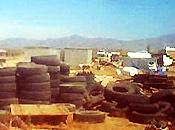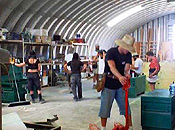As the Work Ranch has evolved from a depository of materials toward becoming a professional facility for the production of Black Rock City and related arts projects, we have learned better ways to organize and manage resources to meet the growing demands of our expanding mission. Every year, building and removing the city involves more people for longer periods of time, bringing more skills and experience to bear on the challenges we face. This development has resulted in more streamlined protocols, better systems, and higher efficiency on the ranch and throughout DPW.
 The most significant improvements in infrastructure this year were achieved in the public area on the ranch, affectionately known as the Beach Club. A higher capacity, more efficient diesel generator with a 500-gallon fuel tank was installed to provide cleaner, more reliable power to the kitchen, office, and camping areas as well as for general use. The kitchen area was expanded with more equipment, and a wooden floor was installed for improved utility in inclement weather and easier cleaning. The water system, which still operates as a temporary installation much like that on the playa, took another leap forward with the addition of a pressure tank, hard plumbing, last year’s on-site dish room, and the long-term loan of a 3,250-gallon potable-water tank trailer. These improvements in particular diminished the demands on general maintenance—from two water runs per day to two runs all month—and they eliminated the need for continuous troubleshooting of temperamental extension cords or fetching of gasoline for the generator. A large, donated mobile home was placed as the northern wind block, which freed up a travel trailer for housing and prompted the construction of a larger stage. Other improvements include a fence to keep dogs out of the main eating area, reconstruction of tables and shade structures, expansion of the office, a larger bar area, and installation of wireless ethernet equipment.
The most significant improvements in infrastructure this year were achieved in the public area on the ranch, affectionately known as the Beach Club. A higher capacity, more efficient diesel generator with a 500-gallon fuel tank was installed to provide cleaner, more reliable power to the kitchen, office, and camping areas as well as for general use. The kitchen area was expanded with more equipment, and a wooden floor was installed for improved utility in inclement weather and easier cleaning. The water system, which still operates as a temporary installation much like that on the playa, took another leap forward with the addition of a pressure tank, hard plumbing, last year’s on-site dish room, and the long-term loan of a 3,250-gallon potable-water tank trailer. These improvements in particular diminished the demands on general maintenance—from two water runs per day to two runs all month—and they eliminated the need for continuous troubleshooting of temperamental extension cords or fetching of gasoline for the generator. A large, donated mobile home was placed as the northern wind block, which freed up a travel trailer for housing and prompted the construction of a larger stage. Other improvements include a fence to keep dogs out of the main eating area, reconstruction of tables and shade structures, expansion of the office, a larger bar area, and installation of wireless ethernet equipment.
 We also moved another step closer to a comprehensive materials storage and tracking program. The inventory database was expanded to include most large assets such as vehicles, buildings, equipment, and so on. Tracking has improved through the introduction of property use agreements. Artists and other participants have taken increased responsibility for securing and winterizing materials and vehicles. A map of the ranch has been developed with corresponding signs marking rows of materials. These rows are increasingly organized by criteria, such as type of material or whether it is privately owned or property of the Project. Individual projects now each have their own cache of tools, which makes inventory easier and prevents loss of tools. Another year’s data on fuel consumption is helping to establish usage patterns, create recharge protocols, and eliminate abuses. A heroic clean-up effort on the ranch both before and after the event has removed much of the abandoned junk and helped to expose useful materials and to free space for other uses. The acquisition of more shipping containers and tractor-trailer box vans improves our weatherproof storage capacity and simplifies transportation, and a more compact placement configuration now allows easier access and will expedite load-out. All of these small accomplishments work in concert to create a more manageable and user-friendly facility.
We also moved another step closer to a comprehensive materials storage and tracking program. The inventory database was expanded to include most large assets such as vehicles, buildings, equipment, and so on. Tracking has improved through the introduction of property use agreements. Artists and other participants have taken increased responsibility for securing and winterizing materials and vehicles. A map of the ranch has been developed with corresponding signs marking rows of materials. These rows are increasingly organized by criteria, such as type of material or whether it is privately owned or property of the Project. Individual projects now each have their own cache of tools, which makes inventory easier and prevents loss of tools. Another year’s data on fuel consumption is helping to establish usage patterns, create recharge protocols, and eliminate abuses. A heroic clean-up effort on the ranch both before and after the event has removed much of the abandoned junk and helped to expose useful materials and to free space for other uses. The acquisition of more shipping containers and tractor-trailer box vans improves our weatherproof storage capacity and simplifies transportation, and a more compact placement configuration now allows easier access and will expedite load-out. All of these small accomplishments work in concert to create a more manageable and user-friendly facility.
DPW undertook a remarkable effort this year to promote safe practices and to improve our ability to deal with emergencies on the ranch. Our intake forms were revised to better capture health information on participants, and a new liability waiver reinforces the individual responsibilities assumed by volunteers and other participants during their stay. An orientation talk was developed and delivered outlining the specific hazards and risks of working and living in the challenging environment of the desert, and production began on a safety video as a tool to improve this communication process. More fire extinguishers and smoke detectors were installed, and availability and access to first-aid kits and personal protective equipment such as gloves and goggles was improved. Black Rock Rangers stationed on the ranch before, during, and after the event helped establish clear communications in case of emergency and increased security, and they aided in the resolution of disputes. A taller antenna tower and more communications equipment also have made it easier to keep in touch with participants within and vendors outside our production area. Roles such as safety coordinator and ranch medic have been formed to manage and inform our practices and guarantee compliance with safety standards. Developing protocols for documenting accidents and identifying potential hazards will be vital in creating a safe living and working environment for all work ranch participants.
 The involvement of artists and of other departments within the Project increased this year, suggesting an expanded role for the facility in the future. The Earth Guardians used the ranch to meet and get oriented for their Leave No Trace training activities in the spring. The Man was again built on the ranch, and the large tent used for the on-site commissary was recovered and set up to determine that it was complete. The involvement by groups such as the crews of the Center Camp Café and Recycle Camp began earlier and lasted longer than ever before. We supported the production and transportation efforts of several large art projects, and the ranch hosted dozens of artists working on site for extended periods of time. We also have many works of art from past years’ events stored on the ranch, and many more stored vehicles, materials, and equipment.
The involvement of artists and of other departments within the Project increased this year, suggesting an expanded role for the facility in the future. The Earth Guardians used the ranch to meet and get oriented for their Leave No Trace training activities in the spring. The Man was again built on the ranch, and the large tent used for the on-site commissary was recovered and set up to determine that it was complete. The involvement by groups such as the crews of the Center Camp Café and Recycle Camp began earlier and lasted longer than ever before. We supported the production and transportation efforts of several large art projects, and the ranch hosted dozens of artists working on site for extended periods of time. We also have many works of art from past years’ events stored on the ranch, and many more stored vehicles, materials, and equipment.
 Office spaces were expanded on the ranch by staff, and the grounds were upgraded by planting trees, recycled sod, and a garden. We were literally fed by the fruits (usually vegetables, actually) of our effort. The Bureau of Land Management has borrowed cones and burn barrels for some of their events, and the ranch has often hosted visits by various officials. In general, the ranch has become more comfortable, more organized, and more accessible to a wider variety of groups working to produce Black Rock City. The next year will see even greater infrastructure improvements to provide more professional support for crew and staff, as the challenges we face today become tomorrow’s triumphs.
Office spaces were expanded on the ranch by staff, and the grounds were upgraded by planting trees, recycled sod, and a garden. We were literally fed by the fruits (usually vegetables, actually) of our effort. The Bureau of Land Management has borrowed cones and burn barrels for some of their events, and the ranch has often hosted visits by various officials. In general, the ranch has become more comfortable, more organized, and more accessible to a wider variety of groups working to produce Black Rock City. The next year will see even greater infrastructure improvements to provide more professional support for crew and staff, as the challenges we face today become tomorrow’s triumphs.
Submitted by,
Matthew Ebert aka Metric,
BRC-DPW Work Ranch Manager

